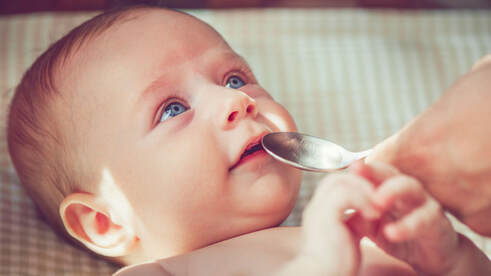 Oh Mom! I Love this Gripe Water Oh Mom! I Love this Gripe Water Crying is the only language known to newborn. They cry when they are hungry, when something is troubling them, if they are suffering from even mosquito bite or when their diaper is overfull. But it is the responsibility of the parents to find out the accurate source for the tears, correct it and help the infant resume sleep or movement of his/her hands and legs. While its often any of the above-quoted reasons sometimes when you notice keenly you can observe that the infant cries continuously during a particular period of the day some days of the week. If that’s the case your kid might be suffering from infantile colic. Infantile colic is defined as episodes of inconsolable crying in an otherwise healthy infant younger than three months of age that lasts at least 3 hours a day and occurs at least 3 days a week over the course of at least three weeks in a month-this is a definition proposed first by Wessel. But a recent definition conveys that colicky infants cry constantly during the evening at the same time every day for at least a week but otherwise they are healthy. I guess many of you are interested to read further about this condition as most have faced or are facing this problem in bringing up our munchkins. Existing as a common condition around the world infantile colic affects one in five infants younger than three months affecting almost 28% infants in the first month of life. The symptoms worsen around 6 weeks after childbirth and improve gradually thereon. But we do have a Canadian study showing that 6.4% infants suffered from persistent colic symptoms at 3 months of age. Breastfeeding is advised until the infant’s sixth month and in such breastfed infants colic episodes are more common during late evening or early morning hours. Such disruptions during such odd hours ultimately results in maternal exhaustion and tiredness. Its been proposed that colic is not a sign of worry and there is nothing dangerous about it but it does indeed exist as a major burden to family members as it many-a-time leads to maternal depression (owing to unrealistic parental feeding expectations, irregular sleep patterns and constant worry over the baby) and might also cause shaken baby syndrome. There are even chances that the baby might stop breastfeeding earlier than expected and colicky behaviour that continues beyond the expected three months or so paves way for later sleep problems, allergic disorders, family dysfunction and behavioural problems. At a Loss for the Cause behind Colic Problems Almost every child faces this problem of infantile colic and the reasons remain elusive but we have various theories proposed. Colic might simply be a part of the regular crying protocol followed by kids. There is even a hypothesis that it is due to the impact of abnormal gastrointestinal motility and pain signals from pathways in the gut. It has also been proposed that the absence of adequate lactobacilli in the gut and increased presence of coli in intestinal microbiota affect gut motor functions and gas production thereby leading to such a condition. Lactose intolerance, gut contractions, mistaken interpretation by parents when the child cries normally, lack of adequate parent-child interaction, family tension and parental anxiety are some of the assumed causes of infantile colic. Increased maternal age has also been proposed as a cause for colic action in infant. On a Hunt Against Colic Brunt If you notice, the very word ‘colic’ has an abdominal origin. But studies have failed to show a positive link between gastro-oesophageal reflux and crying in infants younger than three months old. A randomized control trial (RCT) in both breast-fed and formula-fed infants revealed that at two weeks of age the incidence of crying more than three hours a day was 43% in formula-fed infants and 16% in breast-fed infants. A recent trial proposed that one week of low allergen diet among exclusively breastfed infants (6 weeks old) with colic reduces the risk of colic symptoms by 37% and this brings upon hope that diet alterations in maternal women might bring about some positive changes. A herbal drug containing chamomile, vervain, liquorice, fennel and balm-mint given to infants suffering from colic thrice a day showed marked improvement after seven days. But above all this a mother’s intervention might provide the best possible results against colicky infants. The study below is about one such intervention by moms. Cross-sectional Study The cross-sectional study involved infants younger than three months of age who had been diagnosed being colicky by their paediatrician. It included both breast-fed and formula-fed infants while those with diarrhoea, vomiting and abdominal distention were excluded. This left the study team with 400 infants of whom 181 were male and 173 were female. Moms were around 27 years of age and the infants birth weight were around 3100-3500 grams. 34% of the infant’s family had history of colic, 48.5% had normal vaginal delivery (NVD) and 92.5% mothers received breastfeeding training at the hospital. 196 infants (49%) were colicky and 204 infants (51%) were not. All the mothers imposed behavioural, nutritional or medical types of intervention to control infantile colic. Behavioural approaches used included responding to the crying baby by feeding, hugging, carrying around, wrapping the child in clothes (swaddling), using a pacifier, giving him/her toys, playing music, putting the baby to sleep or giving the baby to someone else as the mother could not cope up with stress. Nutritional approaches followed by the moms included avoiding grains, cereals, dairy, vegetables and meat. Sometimes the mother consumed herbal tea, administered herbal tea to infants or both the mother and the baby consumed herbal tea. Chemical drugs were also consumed sometimes by the mother and some other times by the baby. Behavioural intervention showed that the researchers could find significant difference between the two groups because of two main factors that included family income and mother’s education. In nutritional intervention, a significant difference was found between the two groups in their avoidance of a specific kind of food in accordance with the type of feeding. If the mother breastfed, she was actually pursuing more nutritional interventions. The herbal intervention group did not find any difference depending on family income, mom’s education level, family history of colic, infant sex, type of feeding, breastfeeding training and mother’s job. Non-colic group showed that both moms and babies consumed more herbal tea than those in the colic group. Herbal tea consumption by mothers in the colic group was greater than those in the other group. When it came to comparing chemical drug intervention there was significant difference found between the two groups as a result of family income, mother’s education, infant’s birth order, mother’s age and previous breastfeeding training. Chemical intervention was mainly in the form of gripe water in these infants. Now, there would be a smile in many readers faces as this is one of the oldest solutions used to soothe a crying infant. Effect of Maternal Diet Intervention on Colicky Infants A randomized, control trial was performed by a study group to test whether elimination of allergic food proteins from the maternal diet helps to reduce crying and fussing in infants. The study included exclusively breastfed infants <6 weeks of age suffering from colic problem. The moms were informed that the study included two different diets that were proved to be beneficial in colic-affected infants which ultimately led to the elimination of strict vegan diets. One was a low-allergen diet that excluded major food allergens and the other was a control diet that included the excluded foods by the first diet group as well. None of the diets included those containing food preservatives, colours and additives. All the moms were randomly assigned to one of the two groups. Low-allergen diet: Moms were asked to exclude all foods containing dairy products, soy, wheat, eggs, peanuts, tree nuts and fish from their diet. The diet primarily included meats, a rice milk drink, vegetables, fruits and cereals (corn and rice). Calcium supplements were prescribed and moms were also subscribed a plant-based drink in powder form alongside a daily consumption of fresh rice bread. Control diet: This diet excluded all those foods excluded from the low-allergen diet. All moms were asked to eat 1 serving of peanuts, 1 serving of wheat and 1 chocolate muesli per day besides maintaining their intake of meats, rice, vegetables and cereals. All the mothers received soy and cow’s milk powder mixture to make 500mL of milk which was consumed every day for 7 days. Cry and fuss charts were recorded by the mothers on the study days. Results A total of 107 infants entered the study of which 90 (84%) completed the trial successfully. 47 of 53 from the low-allergen group and 43 of 54 from the control group completed the study successfully. Only those who experienced more than 25% reduction in crying/fussing rates were included in the results that showed that 35 of the 47 infants responded to the low-allergen diet program compared to 16 of the 43 infants on the control diet. Changing the cut-off to 20% did not show any changes in the results. When all non-completers were taken as non-responders, they witnessed a 36% risk reduction in the low-allergen diet group. At the end of the study 61 of 90 infants still suffered from colic crying or fussing for a prolonged period of time. But, the cry/fuss duration per 48 hours was reduced by a greater proportion in the low-allergen group. We also have studies showing that replacing cow’s milk with soy and other milk varieties helps in reducing occurrence of colic problems in infants. It is essential that the condition is treated and minimized in any authentic way to help families, reduce risk of depression in mother, ease the child out of the situation and also avoid early breastfeeding cessation. References Effective Interventions of Mothers in Colicky and Non-colicky Infants: https://www.omicsonline.org/open-access/effective-interventions-of-mothers-in-colicky-and-noncolicky-infants-2167-0846-1000305-96060.html Effect of a Low-Allergen Maternal Diet on Colic Among Breastfed Infants: A Randomized, Controlled Trial: https://pediatrics.aappublications.org/content/pediatrics/116/5/e709.full.pdf?origin=publication_detail Dietary Manipulations for Infantile Colic: https://www.ncbi.nlm.nih.gov/pmc/articles/PMC2791658/ Infantile Colic: https://www.ncbi.nlm.nih.gov/pmc/articles/PMC6091773/ Comments are closed.
|
AVOID FRAUD. EAT SMART+91 7846 800 800
|
- Home
- Written Testimonials
- Consult
- Clinics
- Blogs
-
Diet & Nutrition
- Diabetes Reversal
- IVF IUI not needed for PCOS PCOD Infertility
-
Medical Nutrition
>
-
Disease & Conditions
>
- Infertility | PCOS
- Diabetes Mellitus
- Cholesterol
- Hypothyroid
- Kidney Problems
- Hypertension
- Cardiovascular Diseases
- Liver Diseases
- Gastro intestinal disorder
- Cancer
- Metabolic Disorders
- Orthopedic Disorders
- Eating Disorders
- Dietary Recall
- Weight Record Filled By Clients
- Online Payment Transaction Details
- Online Clients Weight Check Form
- Our Program Package Service Charges
- Weight Record 2017 Clients
- Measurements sent by Clients
- Terms & Conditions Of Payment
- Thanks. Your Form is Submitted
- Video Testimonials
- Lifestyle & Wellness
- Lifestyle & Wellness Blog
- Allergy & Intolerance
- Weight Loss / Gain
- Weight Loss / Slimming Blog
-
Disease & Conditions
>
- Life Cycle Nutrition >
- Sports Nutrition >
- Integrity in Nutrition
- Knowledge Centre
© COPYRIGHT 2022. ALL RIGHTS RESERVED. FRST HEALTHCARE PVT LTD.
Dr. Nafeesa Imteyaz of First Eat Right clinic, is the Best Dietitian Nutritionist in Bangalore. Best Dietitian Nutritionist in Pune. Best Dietitian Nutritionist in Hyderabad. Best Dietitian Nutritionist in Chennai. Best Dietitian Nutritionist in Mumbai. Best Dietitian Nutritionist in Delhi. Best Dietitian Nutritionist in Kolkata.



